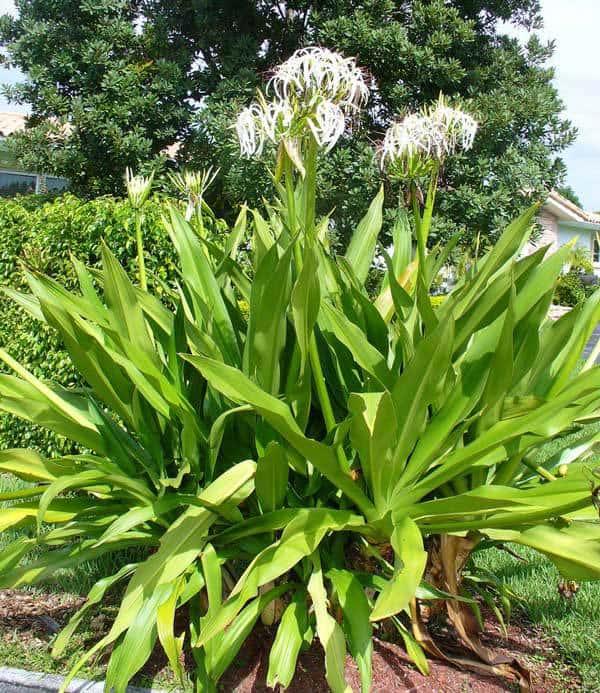Crinum lily bulbs… they’re exotic, related to the Amaryllis plant, with exciting “bell-shaped” fragrant flowers that come with a lovely sweet scent.

In Greek, the name Crinum simply means “Lily.” By all the looks and feel, Crinum plants have all the characteristics of a lily.
Crinum Lily Plant Quick Care Facts
- Origin: South Africa
- Family: Amaryllidaceae
- Botanical Name: Crinum
- Common Name: None, sometimes called “spider lily.”
- Plant Type: perennial plant and sun-loving bulb
- Size: 24″ inches to 6′ feet tall and wide
- Flowers: large fragrant flowers in white to pink to wine-red
- Bloom Time: late spring and late summer
- Hardiness: USDA hardiness zone 6b – 11 depending on the variety
- Exposure: Sun-loving plants
- Soil: rich, moist soil
- Water: drought tolerant but does better well watered
- Fertilizer: balanced liquid fertilizer during the growing season
- Propagation: division of side shoots
- Pests & Problems: grasshoppers and aphids
These plants have all the typical “periods” we find in the lily family:
- Definite rest period
- Exact growth period
- Certain flowering period
Big Long Necked Crinum Lily Bulbs
Crinum asiaticum (also known as Crinum amabile or crinum amoenum) is one of the largest crinum bulbs at maturity, with a leek-like base up to 8” inches in diameter and giant leaves up to 4’ or 5’ feet long and 6” inches broad. It is an important landscape plant in Florida.

Bulbs of Crinum lilies are much larger than underground bulbs of its relative, the Amaryllis (Amaryllidaceae). Roundish, with long tapering necks, individual bulbs of a crinum can be 12″ to 16″ inches in length.
Generally, the leaves are thin and long with a “silky” feel, and some crinum lily varieties have wavy edges.
The flowers are unique and beautiful, but even with the crinum flowers, the crinum is a handsome decorative plant that can get very large.
Because of their size, crinum lilies require more room than ordinary amaryllis bulbs. They are among the most interesting and rewarding of the amaryllis types to grow in a garden.
Multiple Flowers Together
The long, slim flower stalks push themselves high above the elegant leaves to display their wares.

A stalk of crinum flowers blooms for weeks. However, individual flowers last only a few days. Sometimes, flower stalks will continue to follow the old ones coming into sight, extending the showy bloom parade.
Rapid Flower Stalk Growth
It’s not as fast as bamboo… but flower and leafless stalks on crinum lilies bloom quickly. From nowhere to a 24-inch stalk, surprisingly fast. Sitting atop is a full accompaniment of fat flower buds.
Flowers in groups of 6-10, curving at the edge, some bell-shaped, some curved, and some spidery looking.
Crinum Lily Care
Crinums can be unpredictable. When they bloom depends on “their” rhythm. They can bloom in the spring, winter months, or summer.
It all comes down to each crinum lily bulb after its rest period.
Crinums in The Landscape
Many cape lily crinums indeed require more room than ordinary amaryllis-type bulbs. But Crinums are among the most interesting!
Growing Crinum plants outdoors in the landscape is fairly easy in USDA zones 7-10.
Crinum plants have been called “anti-social” since they do best when they do not compete with other fragrant plants in the garden. They can grow to be very old.
They demonstrate their low maintenance by thriving untended in old country gardens, abandoned homesites, and neglected cemeteries.
They perform best in full sun (but not burning sun, partial shade from the sun’s extreme heat), so give them all they can get and well-draining soil.
Fertilize twice a year with a balanced and granular fertilizer. They make wonderful specimens and very attractive pool plants for landscaping by a pool.
One of the most beautiful of all the “spider lilies” is the beautiful ‘Queen Emma Plant Crinum lily. Its strappy leaves reach a height of about 5 feet tall with sweet-scented flowers.
Queen Emma Lily makes a nice centerpiece in the garden with handsome foliage even when not in flower. For best performance, provide full sun.
The “Giant Spider Lily” As Potted Plants
Crinums thrive in normal temperatures found in most homes. They are sensitive to cold and drafts.
When going into their hibernating period, crinums do not always die back. Generally, they do but not always. If that is the case, give them plenty of water.
As new growth starts, cut off the old and dead leaves. Turn the pot on its side and wait for the signs of the plant to wake up and start growing again.
Related: Another bulb called spider lily – the Nerine lily.
Repotting Giant Crinums
When the top of the bulb begins to have green tips, the crinum is moving into its growing period. Now is the time for repotting… remember – Large bulb – large pot.
Do not bury the bulb, but leave part of the bulb above the sandy soil. After repotting, thoroughly water the crinum plant, then wait until growth begins before watering again.
Once the plant begins growing, water the plant regularly, allowing the soil moist to dry out some between each watering cycle.
Using a complete liquid fertilizer like a 20-20-20, use a liquid food regularly (monthly) during the growing season.
After its growth and flowering period, force the crinum plant back into its rest period by gradually reducing consistent watering.
Propagating Bulbs & Sideshoots
In the summer, offshoot bulbs should develop on the “mother plant.” If the growing container is large enough – allow the bulbs or shoots to develop and leave them on.
In the spring, when repotting, the new shoots should have developed their own roots. Carefully remove the shoots to start more crinum plants. Pot and water them the same way as described above.

Jenks Farmer specializes in swamp lilies in South Carolina (jenksfarmer.com).
According to Jenks, drought-tolerant crinums can grow all across the United States, from Virginia south, across the south, through Texas, and into California.
More on Crinum Lily Care
Growing Bulbs From Seed
The patient flower lover who likes to grow things can gain a deal of interesting experience in cape lily crinum culture by raising them from seed.
Crinum asiaticum, from the tropical Pacific area, seeds freely and has been known to flower for two or three years from seed with special treatment.

Crinum Lily Pest and Problems
Gardeners love crinum lilies as insects rarely attack them. But if an attack is discovered, begin to fight back immediately.
Aphids may be a problem from time to time. A good blast of warm (not hot) water should knock them off. If that does not work, try the natural organic neem oil insecticide for crinum plants or insecticidal soap.
Outdoors or in the southern garden, Lubber grasshoppers can be an issue during different times of the year. For best results, pick them off, try using Diatomaceous earth (DE), or use a spray like Sevin.

Crinum Species
Crinum bulbispermum (formerly known as Crinum longifolium or Crinum capense) an old bulb from South Africa, is the hardiest species known and will bloom four or five times in the Spring in the lower South, starting in February.
Farther north, the blooming season comes later in the year. The flower colors and stems are two to three feet tall.
The individual blooms are delicately trumpet-shaped flowers with segments about four inches long, white with more or less red striping or red flush on the exterior.
It requires good, rich loam and likes a dressing of manure now and then. It does better on well-drained soil than in heavy soil in wet places.
Crinum moorei, a native of southern Natal, has large roundish bulbs with long, heavy tapering necks.
With protection, it can probably be planted considerably far up the Atlantic gulf coastal area but would require deep planting to avoid cold injury to the neck.
In Florida, it can be grown with good results, with the bulb practically sitting on top of the ground.
Crinum moorei is one of the most graceful and elegant crinums, with light pink flowers and bright green, spreading elegant leaves in a whorl at the top of the long neck.
The plant is deciduous and loses its purplish leaves in the Fall far south. It flowers in summer and likes rich soil and plenty of moisture.
The flowers are campanulate, borne in large umbels with long pedicels and tubes.

Lesser Known Crinum Species
Other popular crinum species worth trying in any collection are:
First, Crinum seabrum, with wide-open, amaryllis-like flowers, white and striped scarlet
Crinum giganteum, a rare pure-white African species, has wide-open tulip-like flowers
Crinum americanum, (swamp lily) is a sturdy and half-hardy, stoloniferous kind with white, star-like flowers
Crinum augustum, also known as the Queen Emma Crinum Lily
Crinum pedunculatum, commonly known as the Southern Swamp lily or River Lily. Very similar to Crinum asiaticum but smaller, with broader and more colored leaves.
Crinum procerum, Rich, purple-burgundy leaves, and a show stopper. Mature clumps can grow to reach 6′ across. Best foliage color in full sun.
Crinum scabrum, considered by some as the “most beautiful crinum” here.
Crinum mauritianum, Thought to be extinct, was rediscovered in 1973 near Midlands Dam (Barrage de Midlands) in Mauritius. It’s become an ornamental in Mauritius and is used frequently in landscaping.
Crinum latifolium, with white flowers from Asia and reportedly naturalized in the West Indies. The crinum latifolium (crinum prostate) extract is known to cure rheumatism, fistula, and whitlow and stop the growth of prostate tumors.
Crinum “Ellen Bosanquet” is a hybrid by Louis Bosanquet with beautiful wine-red flowers named after his wife.
In the southern landscape, the crinum makes a wonderful addition and statement with its size, foliage, flowers, and over beauty.
Image: asiaticum scott.zona
